 Features
Features

The Quảng Nam Tourism Association has been building up a fish sauce making village as a destination linked to Hội An, Mỹ Sơn Sanctuary, other craft villages, farming tours, and cultural and educational experiential tours.
Công Thành
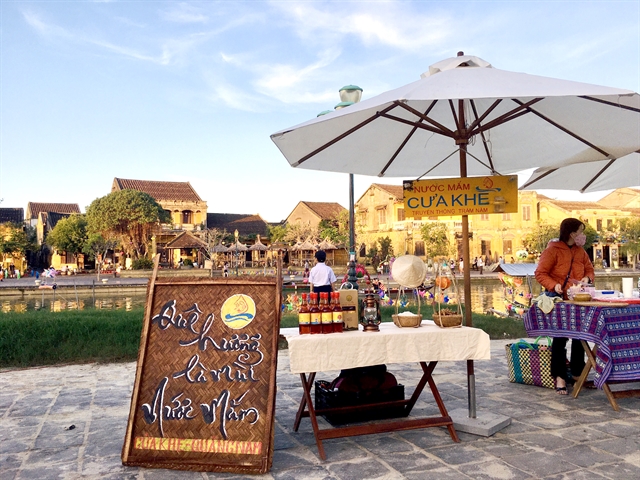
|
| FAIR TRADE: A stall introducing Cửa Khe fish sauce at a fair in Hội An ancient town. Photo courtesy of Cửa Khe fish sauce cooperative |
Sixty-year-old Nguyễn Thị Tám has been making fish sauce for nearly half a century and has developed her own brand -- Tám Tươi -- within the line of fish sauce made by the Cửa Khe cooperative.
The name Cửa Khe derives from the Khe estuary, used last century by fishing vessels heading out to and returning from sea, and the fish sauce has been developed for more than a hundred years.
Tám, born in Duy Hà fishing village in coastal Bình Dương Commune in Quảng Nam Province, said she learned the trade from her father and is the fourth generation of villagers involved in production, and even continued to work in the craft after marriage.
“Most women in the village know how to make fish sauce, as we have fish reserves year-round and the trade developed over such a long period of time,” she said.
“Artisanal fish sauce has been hit hard by mass-produced brands in recent decades. There are about 70 families in our village still in the trade, producing 11 brands that meet high-quality standards and are readily found on supermarket shelves.”
Premium recipes
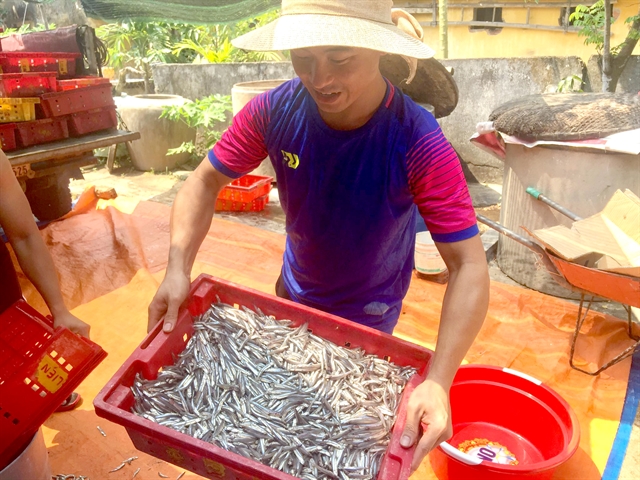
|
| LATEST CATCH: A local villager carries fresh grey anchovies for fish sauce production in Duy Hà Village. VNS Photo Kim Ngân |
Tám said making traditional fish sauce is still done based on unique recipes and strict selection of fish and salt.
Grey anchovies and salt from the Đề Gi salt field in Bình Thuận Province, she explained, are the best raw materials when making premium Cửa Khe fish sauce.
March is the anchovy fishing season, and Tám’s family can buy 40 tonnes of top-quality fish between March and June, which are mixed with salt for fermentation.
“We follow our unique formula, of three kilos of fish for one kilo of salt,” she said. “The salt must be stored for 12 months before being mixed with anchovies or other fish to produce the best fish sauce.”
“Anchovies must be brought directly to our workshop as soon as boats dock at dawn. No ice or additives are allowed in preservation.”
Tám said the first drops of amber liquid leaking out from wooden barrels after 12 to 13 months of fermentation are 'premium' quality, or nước mắm nhĩ in Vietnamese, and sell for VNĐ70,000 (US$3) a litre.
Two kilos of fish are needed to produce one litre of premium fish sauce for sale in the high-end segment.
“Even a small amount of chemical or some rotten fish can spoil a huge batch,” she explained. “The process requires sunlight, as cool weather can result in the fish sauce taking on a black colour.”
Most of the production is done in the scorching days of summer, until the wet season arrives in the central region some time during October.
Together with premium fish sauce, local craftspeople also produce an option in the lower-price segment that is a combination of different batches.
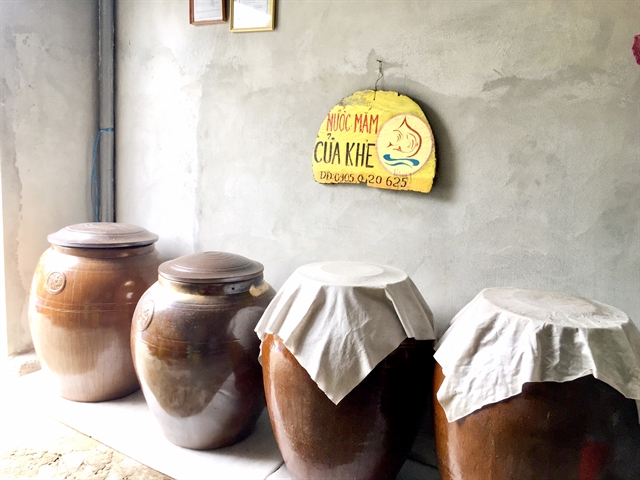
|
| PREFERRED KIT: Terra-cotta vats are used to ferment fish in salt, with the first drops of sauce appearing after several months. VNS Photo Võ Tùng |
Hà Văn Thuận, 31, said this lower-price fish sauce is produced after the premium process is completed, to use all available materials.
“We offer different types of fish sauce, with prices ranging from VNĐ15,000 ($0.7) to VNĐ40,000 ($1.7),” he said. “The lower-quality sauce is often used by street vendors as well as low-income families.”
High protein fish sauce is quite rare and so ideal as a gift on special occasions like Tết (the Lunar New Year festival).
“This is a special variety that collects all of the protein from fermented anchovies,” he said. “It is also much savoury.”
Fish residue that remains at the end of the production process can also be used as livestock feed or fertiliser.
He said that mắm nêm, or salted fish paste, another product made from anchovies but with less salt, is also popular in dishes in the central region.
Traditionally, villagers used terra-cotta vats or jackfruit wood barrels to ferment fish, but some households replaced these with cement-cast barrels to cut costs amid a lack of wood and a growing absence of earthenware makers in recent years.
Thuận said the Cửa Khe cooperative encouraged producers to use wooden barrels or terra-cotta vats.
Good for health
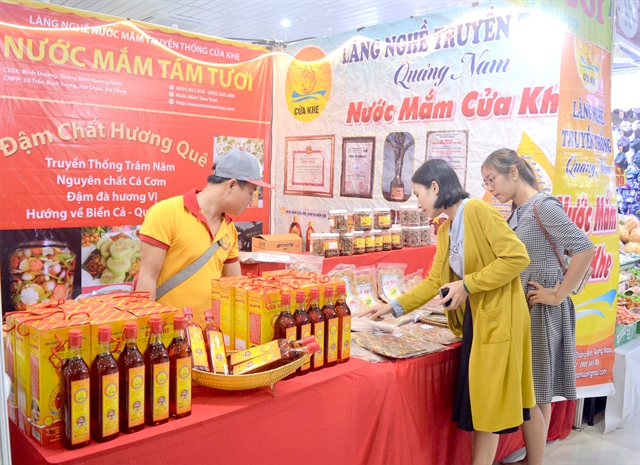
|
| FAVOUR FOUND: Customers visit a Cửa Khe fish sauce stall at an organic fair in Đà Nẵng. VNS Photo Kim Ngân |
The village produces 150,000 litres of premium fish sauce each year for sale at traditional markets in Quảng Nam, Đà Nẵng, Hà Nội and HCM City. The sauce is also sold at Co-Op Marts in the central region, according to Võ Nguyên Tùng, a member of the Cửa Khe cooperative.
Hà Thị Nguyệt, an agent in Đà Nẵng, helps deliver Cửa Khe fish sauce to consumers around the city.
“Central coastal villages are seen as producing the best fish sauce,” she said. “The careful selection of top-quality fish and salt wins over choosy customers.”
“They prefer premium fish sauce because they know for certain there are no food additives used.”
She added that fish sauce is considered a healthy organic product.
Tùng, who owns the Cửa Khe-Quảng Nam fish sauce company, said local villagers recognised the importance of the product for the local markets.
“We plan to develop community-based tourism to preserve our craft and advertise Cửa Khe fish sauce,” he said. “The village, which is close to the Hoiana resort and the ancient town of Hội An, could be linked to them as a craft destination.”
Some household brands have been built under the “One Commune One Product” (OCOP) programme.
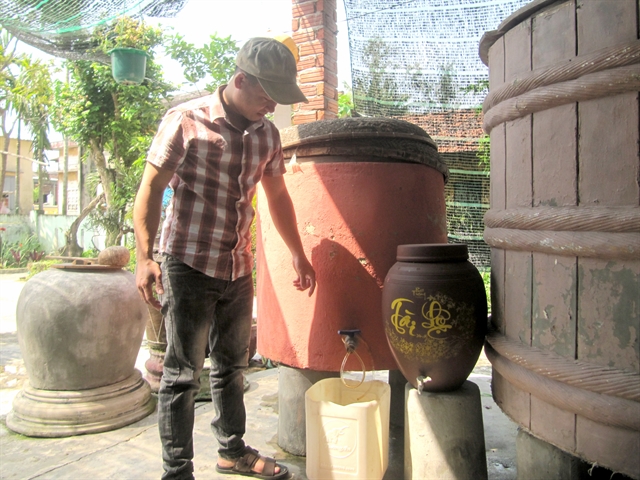
|
| FRESH BATCH: A local craftsman collecting the first drops of fish sauce from vats at a workshop in Duy Hà Village. VNS Photo Công Thành |
The Quảng Nam Tourism Association has indeed been building up the village as a destination linked to Hội An, Mỹ Sơn Sanctuary, other craft villages, farming tours, and cultural and educational experiential tours.
Boosting promotions in line with community-based tourism would help preserve the craft and create stable incomes for local villagers, Tùng believes.
Cửa Khe fish sauce, he added, was also seeking export opportunities to European markets. VNS




